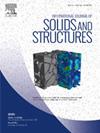Forced vibration analysis of a spinning Timoshenko beam under axial loads by means of the three-dimensional Green’s functions
IF 3.4
3区 工程技术
Q1 MECHANICS
International Journal of Solids and Structures
Pub Date : 2025-03-06
DOI:10.1016/j.ijsolstr.2025.113324
引用次数: 0
Abstract
Vibration of spinning structure is a very important and common problem in rotation machines and oil drilling. This paper studies dynamic responses of a spinning Timoshenko beam (STB) under the combined action of axial force and external excitation, and the three-dimentional (3D) steady-state Green’s function of forced vibration of the spinning beam is derived, in a systematic manner, which are actually constructed by two components i.e. two Green’s functions in two vertical directions. The Hamilton’s principle is used to establish forced vibration equations of the STB. By employing the separation of variables method and Laplace transform method, the 3D Green’s functions of STBs are obtained for different boundary conditions. By setting the shear correction factor k to infinity and the moment of inertia γ is set to zero, the present 3D Green’s functions can be reduced to the spinning Rayleigh beam and Euler-Bernoulli beam cases. In numerical section, the present analytical solution is verified by finite element method results, experimental results, and results in references in this work. Influences of the cross-section shape, such as circle, square, and ring, to the present solutions are discussed, and influences of some important geometric and physical parameters, such as the spinning speed and axial force, to the present solutions are also discussed.
求助全文
约1分钟内获得全文
求助全文
来源期刊
CiteScore
6.70
自引率
8.30%
发文量
405
审稿时长
70 days
期刊介绍:
The International Journal of Solids and Structures has as its objective the publication and dissemination of original research in Mechanics of Solids and Structures as a field of Applied Science and Engineering. It fosters thus the exchange of ideas among workers in different parts of the world and also among workers who emphasize different aspects of the foundations and applications of the field.
Standing as it does at the cross-roads of Materials Science, Life Sciences, Mathematics, Physics and Engineering Design, the Mechanics of Solids and Structures is experiencing considerable growth as a result of recent technological advances. The Journal, by providing an international medium of communication, is encouraging this growth and is encompassing all aspects of the field from the more classical problems of structural analysis to mechanics of solids continually interacting with other media and including fracture, flow, wave propagation, heat transfer, thermal effects in solids, optimum design methods, model analysis, structural topology and numerical techniques. Interest extends to both inorganic and organic solids and structures.

 求助内容:
求助内容: 应助结果提醒方式:
应助结果提醒方式:


